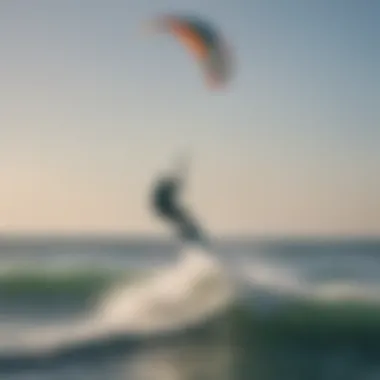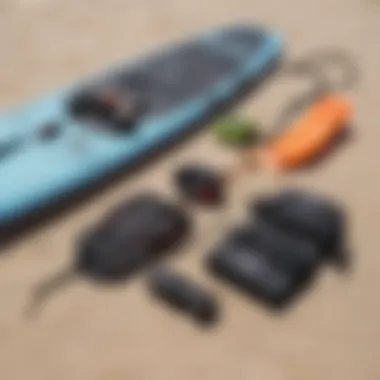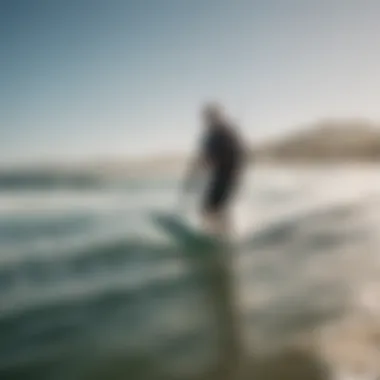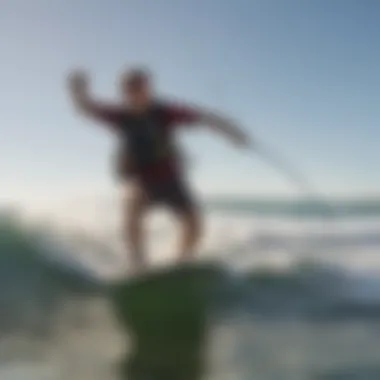Kitesurfing in Los Angeles: An In-Depth Exploration


Intro
Kitesurfing isn't just a sport; it's a passion that takes over a person's soul. In Los Angeles, where surf culture thrives, kitesurfing offers a unique blend of excitement, freedom, and connection to nature. This vibrant city with its sprawling beaches and consistent winds is a playground for both seasoned pros and eager newcomers.
What draws individuals to the beaches of LA is not merely the allure of the ocean, but the community surrounding this exhilarating sport. Picture golden sunsets reflected on the water while fellow kiteboarders carve through the swells—this is the lifeblood of the kitesurfing scene here. But before you grab a kite and hit the waves, understanding the right gear, local spots, and safety measures is essential.
In this exploration, we will traverse through various aspects of kitesurfing in Los Angeles. From gear selection and skills required to advance your technique, we aim to equip practitioners of all levels with valuable insights. Additionally, we’ll touch on the environmental impacts and community initiatives to promote responsible kitesurfing. So, whether you’re looking to catch your first gust of wind or perfect your jumps, this guide provides the framework for a fulfilling kitesurfing journey.
Gear Selection
Gear is the backbone of every kitesurfer's experience. Picking the right equipment can make or break your time on the water. But with so many options available, navigating through various choices can feel like trying to find a needle in a haystack. Here, we’ll break down the essentials.
Types of Kites
The heart of kitesurfing lies in the kites themselves. Understanding the different types can seem daunting, but it's crucial for maximizing your performance:
- Ram-Air Kites: These are often used for learning due to their stability. They offer a predictable ride and are less susceptible to crashing.
- Bow Kites: These kites generate a larger wind range. They are versatile and good for intermediate and advanced riders who want to try various conditions.
- C-Kites: Known for their powerful pull and amazing responsiveness. They are favored by freestyle riders for their pop and trick potential.
Knowing your environment plays a big part in selecting your kite. Los Angeles' beaches can have varying conditions, so it's wise to own a couple of kites for different wind strengths.
Choosing the Right Board
When it comes to the board, it’s not one-size-fits-all. There are different styles tailored to specific riding conditions:
- Twin-Tip Boards: These are most popular and suitable for beginners and freestyle riders. They offer stability and are easy to maneuver in various waters.
- Directional Boards: Ideal for those who want to ride waves. They provide excellent control during fast turns and can handle stronger winds better.
- Foil Boards: A cropped innovation, these boards allow riders to enjoy the water even in low winds. They elevate above the surface, offering a unique experience that’s incredibly exhilarating.
To summarize, selecting the right kite and board goes beyond preference; it involves understanding your existing skills, local conditions, and intended riding style.
"The right gear doesn't just enhance performance; it shapes the entire experience of kitesurfing."
Skill Development
Once you’ve got your gear situation sorted, it’s vital to nail down the skills that will let you tap into your potential as a kitesurfer.
Essential Techniques
Grasping the basic techniques is essential for safety and enjoyment:
- Water Start: Learning how to get up from the water is a rite of passage. Practice makes perfect here.
- Edge Control: Being able to manipulate the board under your feet in both directions is crucial.
- Riding Upwind: This is a skill every kitesurfer must master; it allows you to return to your starting point, no matter where the wind blows you.
Progression Tips
Improving in kitesurfing is much like climbing a staircase. Focus on gradual advancement rather than sudden jumps:
- Set Achievable Goals: Break down your objectives. Instead of aiming for complex tricks, focus on honing specific techniques.
- Film Yourself: Watching your rides can offer insights on areas that need improvement.
- Seek Feedback: Engage with the kitesurfing community in Los Angeles. Often, fellow enthusiasts can provide tips that books or videos cannot.
By fine-tuning your skills and being aware of your capabilities, you can elevate not just your technique but also your overall experience.
The journey of kitesurfing is as dynamic as the sport itself. With the right gear and a focus on skill development, anyone can glide across the waves of Los Angeles with confidence.
Foreword to Kitesurfing in Los Angeles
Kitesurfing, a sport that marries the exhilarating elements of wind and water, is a prominent recreational activity found in the vibrant coastal city of Los Angeles. Nestled between the urban landscape and the expansive Pacific Ocean, LA offers a unique playground for kiteboarders. The importance of kitesurfing in this area is not just about riding the waves; it’s about the culture, the community, and the connection to the urban environment.
In this section, we delve into what kitesurfing is and why it captivates so many. There’s an undeniable appeal in navigating the swell of the ocean with the wind at your back, and for those residing in or visiting urban settings, this sport brings a refreshing escape from the daily grind. Kitesurfing in Los Angeles provides an opportunity for adrenaline seekers and peace finders alike to come together, sharing in their love of flying and riding while fostering friendships across a multitude of backgrounds.
What is Kitesurfing?
Kitesurfing combines elements of surfing, windsurfing, and paragliding. Simply put, it involves riding on a board while being pulled by a large kite. The kite is controlled by the kitesurfer through a harness and bar system, allowing for jumps, tricks, and an overall feeling of flight. To the novice, it might seem as if you are flying across the water, gliding seamlessly like a bird.
The equipment typically consists of a kite, a board, and a harness, each crucial for safety and control. Kites can differ in size and design, and learning to choose one that matches your skill level and wind conditions is vital. Kitesurfing also requires specific skills, such as managing wind direction and speed, balancing on the board, and knowing how to steer the kite effectively.
The Appeal of Kitesurfing in Urban Environments
Kitesurfing in an urban environment like Los Angeles presents a unique blend of thrills and accessibility. The urban backdrop of iconic landmarks, paired with the expansive water, makes it visually stunning while offering convenience. Riders don’t have to travel far from the city’s hustle to enjoy the serenity of the sea, and that’s a huge draw.
Additionally, the social aspect of kitesurfing in LA adds to its allure. Beaches often pulsate with energy, filled with fellow enthusiasts eager to share tips or experience the thrill together. Collaborating within this vibrant community fosters a sense of belonging, where seasoned kitesurfers mentor newcomers and friendships develop over a shared passion.
Moreover, this sport promotes an active lifestyle, encouraging participants to engage with nature while enhancing physical fitness. As one navigates the waves, the sense of freedom and adventure becomes palpable. In a world that often feels chaotic, there's something profoundly grounding about kitesurfing, offering both a personal challenge and a way to connect with others who share similar pursuits.
"Kitesurfing in Los Angeles is not merely a hobby; it’s a lifestyle, a community, and a breathtaking experience that bridges the urban and natural worlds in a way that few activities can."
In essence, kitesurfing embodies more than just the sport itself. It's a gateway to discovering the coast, fostering connections, and reclaiming a bit of the wild in an otherwise structured urban life. The following sections will further explore the notable spots, gear essentials, and the growing community of kitesurfers right here in Los Angeles.
Top Kitesurfing Locations in Los Angeles


Kitesurfing is not just a sport; it’s a lifestyle that intertwines with the vibrant culture and stunning landscapes of Los Angeles. The city is peppered with prime kitesurfing spots, each possessing unique characteristics that cater to both novice and seasoned riders. Understanding the favored kitesurfing locales is crucial for enthusiasts looking to harness the wind and waves. These areas offer essential elements such as wind patterns, wave conditions, and safety features, making them pivotal in ensuring a quality kitesurfing experience.
Highlighting top locations provides insights into where the action is and what each site has to offer. Give a nod to the varied environments, from bustling beach scenes to tranquil spots away from the crowds. Let’s dive into the specifics beyond just the map coordinates.
North Beach
North Beach is celebrated for its consistent winds and spacious stretches of water. Located near the iconic Venice Beach, it provides a vibrant atmosphere where riders can enjoy both the surf and the local culture. The beach's length allows for a range of kitesurfing skills to flourish, from beginners learning the basics to advanced kitesurfers perfecting their tricks
It’s important to note that North Beach can attract sizable crowds, especially during peak season. This brings both excitement and some challenges, such as navigating around fellow surfers and beachgoers. Consequently, practitioners are advised to stay vigilant and aware of their surroundings. Local instructors often set up camps here, giving newcomers a chance to learn from seasoned professionals in a lively community setting.
South Bay
Shifting southward, we discover the South Bay, which includes popular spots like El Porto and Manhattan Beach. This locale is known for its more forgiving waves and steady winds, providing an excellent playground for those looking to hone their skills without the intimidating surf.
The sheltered coves around these beaches offer a unique experience, especially for learners. The atmosphere is more laid-back compared to the hustle of North Beach, allowing for a more focused practice. Moreover, South Bay often sees less traffic, which is a significant consideration for safety and ease of learning.
For kitesurfers seeking equipment rentals or lessons, there are several shops nearby that cater specifically to this community, ensuring that both novices and veterans alike are well-equipped.
Santa Monica Pier
Santa Monica Pier, blending the thrill of kitesurfing with an iconic backdrop, is a fantastic location for both sport and scenery. The area is well-frequented by tourists, and as a result, it offers a lively ambiance that’s hard to match. This popular spot is perfect for kitesurfers looking to capture breathtaking views while getting their adrenaline hit.
However, with popularity comes heightened safety awareness. Riders should be mindful of the pier's foot traffic and ensure that their kites aren’t unintentionally crossing paths with beach patrons. Many local schools operate in this area, providing easy access to lessons and safety briefings tailored to the local conditions.
"Santa Monica is where thrill meets tranquility - a true dichotomy for kitesurfers!"
Malibu
One cannot speak of kitesurfing in Los Angeles without mentioning Malibu. Renowned for its sparkling waves and stunning coastline, Malibu offers a more idyllic and picturesque setting. The waves here can be more challenging, making it especially appealing to skilled kitesurfers looking for an adventure. Malibu’s beaches provide ample space for expansive kiting conditions, making it an ideal locale for those seeking to push their limits.
While there are fewer crowds compared to places like Venice Beach, the waves can be unpredictable. Therefore, it’s advisable for kitesurfers to possess a solid understanding of their equipment and local guidelines. Malibu also hosts various kitesurfing events throughout the year, further enriching the community and providing opportunities for networking and competition.
Essential Gear for Kitesurfing
When it comes to kitesurfing, the gear you use can make or break your experience on the water. Having the right equipment not only enhances performance but also ensures safety, which is paramount for every kitesurfer, from novices to seasoned pros. This section dives into the essential gear needed for kitesurfing, breaking down each component's role, benefits, and considerations.
Kites: Types and Specifications
Kites serve as the heart of kitesurfing, providing the lift that propels riders across the water. There are various types of kites, each designed for specific wind conditions and rider preferences. The main types to consider are:
- Inflatable Kites: These are the most common and versatile options, featuring a large inflatable structure that maintains its shape. Ideal for various skill levels and conditions, they are great for beginning and advanced riders alike.
- Foil Kites: Lighter and less prone to power is provided by airflow beneath the kite's surface. These kites excel in light winds and are often utilized for racing or when you want to maximize speed.
- Hybrid Kites: These kites combine features of both inflatable and foil kites. They cater to those who might want the best of both worlds, offering adaptability and performance under different wind scenarios.
Key Specifications to Consider:
- Size: Generally, a bigger kite catches more wind and is good for beginners, but it can be harder to control. Smaller kites allow for better handling but require more wind.
- Aspect Ratio: High aspect ratios provide improved lift and speed but can be tougher to handle for novices.
- Bridle System: The bridle configuration affects how the kite flies, influencing stability and responsiveness.
Understanding these variables helps in selecting the right kite that matches your style and the conditions in Los Angeles.
Boards: Choosing the Right One
Selecting the right board is just as crucial as picking the right kite. Boards vary significantly in size, shape, and material. Here are the core types:
- Twin Tip Boards: These are symmetrical boards, allowing for riding in both directions. They’re often recommended for beginners due to their easier learning curve.
- Directional Boards: Designed specifically for riding in one direction, these are more akin to surfboards. They’re favored by advanced riders looking for a more challenging experience and often work better in surf.
- Foil Boards: These boards feature a hydrofoil that raises the board above the water surface, allowing for smoother rides even in lighter winds. These have gained traction for their unique approach to kitesurfing.
Considerations When Choosing:
- Length and Width: A longer board offers more stability while a shorter board contributes to maneuverability.
- Flexibility: Some prefer a stiffer board for speed, while others might like a softer feel for better comfort through choppy waters.
Choosing the right board ultimately hinges on understanding what conditions you’ll face locally and matching your personal riding style.
Harnesses and Safety Gear
While gear like kites and boards are vital for facilitating your ride, harnesses and safety equipment ensure you remain safe while enjoying the thrills of kitesurfing.
Essential Harness Types Include:
- Waist Harnesses: These provide a good balance of comfort and performance. They sit on the waist and offer freedom of movement, suitable for most riders.
- Seat Harnesses: For those who value support during long sessions or may have back issues, these harnesses distribute weight more evenly across the body.
Safety Gear Recommendations:
- Life Jackets: Wearing a life jacket is essential, especially for anyone just starting out. It provides buoyancy and keeps you safe in case you take a tumble.
- Helmet: Protecting your noggin is non-negotiable. A helmet helps shield you from potential impacts, making it a smart addition to your gear.
- Impact Vest: This adds extra padding and flotation, combining protection during crashes and helping keep you buoyant in the water.
"Preparation is the key to safety; equip yourself with the right gear, and the ocean will be less daunting."
With the appropriate harness and safety gear, you’ll not only ride with confidence but also greatly reduce the odds of injury, allowing for a more enjoyable kitesurfing experience.


In summary, having the right essential gear for kitesurfing is critical to enhancing both safety and performance. Whether it’s the kite that lifts you or the board that glides underfoot, every piece of equipment plays a crucial role in your kitesurfing journey.
Learning to Kitesurf
In the realm of water sports, kitesurfing stands out for its thrilling blend of freedom and skill. This section emphasizes the significance of learning kitesurfing, which is essential for both enjoyment and safety in this rapidly growing sport. Gaining knowledge through formal lessons not only enhances one's skills but also fosters a deeper appreciation for the water and wind. For those diving into this exhilarating adventure, having a solid foundation is crucial for anyone eager to take to the waves.
Finding the Right School or Instructor
Choosing the right instructor or school may be a daunting task, but it lays the groundwork for a meaningful kitesurfing journey. Los Angeles boasts several reputable kitesurfing schools, each offering unique teaching styles and specialties. A few factors to consider include:
- Instructor Experience: Look for instructors who have years under their belt in both kitesurfing and teaching. Someone with the right experience will not just teach you the moves, but also instill confidence.
- School Reputation: Research online reviews or ask fellow kiteboarders about their experiences with various schools. Networking within the community often leads to valuable recommendations.
- Safety Standards: Ensure that the school follows safety regulations and provides up-to-date equipment. Safety should always be priority number one.
- Location: Some beaches may have better wind and water conditions for beginners. Checking with the school about their preferred spots may help you make a more informed decision.
In summary, taking the time to find a good instructor can set the course for success and enjoyment.
Kitesurfing Lessons: What to Expect
Stepping into the world of kitesurfing lessons offers a mix of excitement and nerves. During your first few lessons, students can anticipate a structured approach that should cover the basics. Important aspects of these lessons typically include:
- Ground School: In this phase, students learn about equipment setup, wind understanding, and safety protocols. This is where they grasp the significance of the kite as an extension of their body.
- On-Water Practice: Eventually, the real magic happens on the water. Under close supervision, students begin with body dragging, which helps them become familiar with the kite while being pulled by it in the water. It can feel like a wild ride at first, but it’s part of the learning curve.
- Guided Learning: As lessons progress, students may progress to standing up on the board and riding. Instructors provide support and constructive feedback, ensuring that students acquire proper techniques.
Expect moments of frustration as well as triumph—this layered approach nurtures resilience while building fundamental skills.
Practicing Techniques and Skills
Once the basics are learned, practice becomes key in mastering kitesurfing. The wind and water may be unpredictable, but regular practice helps in establishing familiarity and comfort with the techniques. Here are some focused areas to work on:
- Consistency: Frequent practice aids in becoming comfortable with kitesurfing dynamics. Whether it’s body dragging or riding on the board, repetitive practice helps solidify skills.
- Strength and Conditioning: Physical fitness plays a big role in how well one can maneuver the kite and board. Consider complementary fitness activities like yoga or resistance training.
- Join Community Gatherings: Interacting with fellow kitesurfers can create a supportive network. Plus, many enthusiasts are more than willing to share tricks and tips.
- Video Review: Record your sessions so you can review your technique. Observing oneself can unlock unexpected insights.
Remember, skill-building is a gradual process. With patience and persistence, kitesurfing can transform from a challenge into a cherished passion.
Safety in Kitesurfing
When it comes to kitesurfing, safety should never be brushed aside. The exhilarating thrill of soaring over waves can easily overshadow the necessity of responsible practices. Kitesurfing isn’t just about the rush; it’s about making sure you return safely after every session. Neglecting safety could result in accidents that might not only jeopardize your own well-being but also that of others around you.
Making this a priority can vastly enhance your experience on the water. You’ll find your confidence soaring just as high as your kite when you know you’re equipped with the right safety knowledge and gear. Here, we’ll explore various vital aspects of kitesurfing safety that every participant should be wary of, especially those getting their feet wet in this thrilling sport.
Understanding Local Regulations
Each location has its own set of rules governing kitesurfing. In Los Angeles, familiarizing yourself with local regulations is crucial. These guidelines might cover everything from designated kitesurfing zones to right-of-way rules among different watercraft users.
Notable regulations often include:
- Restricted Areas: Many beaches have zones where kitesurfing is forbidden, often to protect swimmers or wildlife.
- Permits: Some locations might require permits for kitesurfing or participation in organized events.
- Seasonal Restrictions: Be mindful that certain beaches may have specific seasons where kitesurfing is more permissible than others.
Before hitting the water, take time to research these regulations. Websites like Wikipedia can offer insights into specific local ordinances, while forums like Reddit can provide anecdotal experiences from fellow riders.
Pre-Flight Checks and Considerations
Before you launch into the wind like a bird, it’s essential to perform pre-flight checks. These checks create a safety net that minimizes the risk of accidents.
Key aspects to consider include:
- Equipment Inspection: Make sure your kite, lines, and board are in good condition. Look out for frayed lines or damages that can cause catastrophic failures.
- Wind Conditions: Assess the wind speeds and direction. If it feels too gusty or unpredictable, it may be wise to wait for a better day.
- Weather Reports: Check for any approaching storms or unexpected weather changes.
- Personal Health: Ensure you’re in good physical shape and mentally prepared. Fatigue could lead to poor decision-making.
A checklist can be helpful to remind you of these crucial checks before each session. If you skip these steps, you could open yourself up to unnecessary danger.
Emergency Procedures and Communication
Accidents can, unfortunately, happen even to the most experienced kitesurfers. Having a plan can significantly reduce panic during stressful situations.
Fundamental components of emergency readiness include:
- Know Your Gear: Familiarize yourself with your safety leash and how to release your kite in case of emergencies.
- Floating Devices: Depending on the local regulations, wearing a buoyancy aid may be crucial. Be sure to have a floatation device that’s easily accessible.
- Buddy System: Whenever possible, kitesurf with someone else. Communication between riders can be lifesaving.
- Emergency Numbers: Have local emergency services numbers handy. Store them on your phone and remember to carry a phone in a waterproof case.
"Kitesurfing safety isn’t just for newbies; it’s a commitment for everyone riding the winds."
By taking these measures and remaining vigilant, you’ll not only protect yourself but also contribute to a safer kitesurfing environment for all. The ocean is unforgiving, but with the right approach, you can enjoy its thrills with peace of mind.
The Environmental Impact of Kitesurfing
Understanding the environmental impact of kitesurfing is essential for enthusiasts who not only love the sport but also care about the ecosystems surrounding them. Kitesurfing not only provides an adrenaline rush and a sense of freedom, but it also takes place in delicate coastal environments. Therefore, practicing kitesurfing responsibly is crucial to protect these natural habitats. The balance between enjoyment and conservation should always be at the forefront of every kiteboarder's mind. Not only does this ensure the longevity of kitesurfing itself, but it also preserves the beauty and viability of our beaches and waters.
Ecosystems Affected by Kitesurfing
Kitesurfing typically takes place in marine environments, which means various ecosystems are impacted during the practice. The coastlines of Los Angeles, like many other coastal areas around the globe, are home to rich biodiversity. Aquatic plants, fish species, and seabirds can be affected by kitesurfing activities. Here are some specific ecosystems to consider:
- Seagrass Beds: These underwater meadows are crucial for fish spawning and providing a habitat for creatures. Disruption from kitesurfers can damage these delicate systems.
- Coral Reefs: They're not just in tropical paradises; California has its own unique reef systems. Kitesurfing near these areas can lead to damage if proper boundaries are not maintained.
- Dunes and Coastal Vegetation: These areas help prevent erosion and support various wildlife. Foot traffic and kitesurfing gear can disturb the local flora and fauna.


The extent to which kitesurfing impacts these ecosystems often depends on common practices among kitesurfers, making awareness and adherence to local regulations vital. Protecting these areas is not only a matter of environmental integrity but also a fundamental responsibility as lovers of the sport.
Sustainable Kitesurfing Practices
Sustainable kitesurfing is more than a buzzword; it involves adopting practices that mitigate the potential negative impact on the environment. Here are some critical suggestions for kiteboarders:
- Respect Buffer Zones: Many regions have designated areas where water activities are encouraged, and others where they may harm sensitive ecosystems. Familiarize yourself with local regulations and comply with them.
- Choose Eco-Friendly Gear: Some brands are increasingly focusing on sustainability in their products, using eco-friendly materials and production methods. Opting for gear that is less harmful to the environment can make a difference.
- Practice Leave No Trace Principles: This means cleaning up after yourself, not leaving any equipment or trash behind, and minimizing your impact on the natural surroundings.
- Educate Others: Sharing knowledge with fellow kitesurfers about the importance of maintaining healthy ecosystems can promote a community-wide commitment to sustainability.
- Engage in Local Clean-Up Initiatives: Participating in or organizing local beach clean-ups is a great way to give back to the environment and make your kitesurfing spot a better place for everyone.
"Those who don't take care of their turf will find empty skies and lonely waves."
Kitesurfing can harmoniously coexist with nature, but it takes a collective effort from every participant to ensure the sport's sustainability. When people join hands to care for their surroundings, kitesurfing can thrive and inspire future generations to connect with the ocean and nature.
Kitesurfing Community in Los Angeles
The kitesurfing community in Los Angeles is not just a group of enthusiasts riding the winds; it’s a vibrant network of individuals who share a passion for the ocean and adventure. This community plays a crucial role in fostering both camaraderie and support among kiteboarders of all skill levels. For beginners, the sense of belonging can significantly enhance the learning experience, making what may initially seem intimidating into something approachable and enjoyable. The exchange of tips and tricks, as well as personal experiences, lays the groundwork for growth in the sport.
In addition to personal connections, the community serves as a powerful platform for advocacy regarding the sustainability of kitesurfing practices and the protection of local ecosystems. Engaging in discussions about environmental responsibility while enjoying the waves encourages kitesurfers to be stewards of the beautiful coastline they cherish. This not only preserves the environment for future generations but also solidifies the community’s reputation as conscientious athletes.
Having local hotspots also contributes to the community’s sense of identity. Different spots like North Beach and the Santa Monica Pier become not just locations but gathering points for events and informal meet-ups. These spaces encourage the sharing of experiences, creating a unique culture centered around shared passion for the sport.
"In every kiteboarder, there's the thrill of the ride, the pull of the wind, and an unspoken bond with fellow riders. It's this community that fuels our love for the ocean and adventure."
Local Events and Competitions
Events and competitions serve as the lifeblood of Los Angeles' kitesurfing community. They not only showcase the skills of participants but also foster a spirit of competition and collaboration. Whether it’s a local race or a trick competition, these events attract kiteboarders from diverse backgrounds, sparking enthusiasm and inspiration.
Attending or participating in local events can also enhance your own skills. Watching others maneuver their kites and boards can provide invaluable insights that you may not glean from lessons alone. Following these competitions, it’s common to see a surge in motivation among local riders, as they discuss techniques over coffee or at beach bonfires.
A few prominent events to look out for include:
- The Los Angeles Kitesurfing Festival: A gathering of riders, vendors, and spectators, filled with competitions, demonstrations, and workshops.
- Monthly Meet-Up Events: Informal gatherings where kiteboarders get together to ride, socialize, and exchange tips.
Moreover, competitions are often sponsored by local businesses, which helps to strengthen the ties between the kitesurfing community and the broader community. This kind of engagement can lead to increased visibility of the sport and potentially more opportunities for future events.
Networking with Other Kitesurfers
Networking within the kitesurfing community in Los Angeles is essential for fostering relationships and expanding one’s knowledge base. The act of connecting with fellow enthusiasts isn’t just social, it's also practical. When kiteboarders share recommendations for the best gear, instructors, or local spots, it ensures that everyone benefits from the collective knowledge accumulated over years of experience.
Local forums on platforms like Reddit or Facebook often serve as fertile grounds for discussion and invite individuals to share their experiences, seek advice, or organize group rides. Participating in these platforms can also create opportunities to connect with experienced kiteboarders who can mentor newer riders.
Some ideas for networking include:
- Joining Local Kitesurfing Clubs: They often host groups rides and other events, creating a sense of inclusiveness.
- Engaging in Social Media Groups: These groups can provide immediate support and advice from a wide array of riders.
- Participating in Kitesurfing Workshops: Learning alongside others can deepen connections and enhance skills through collaboration.
Thus, establishing connections is more than just making friends; it's about growing within a community that supports each other, fostering a shared respect for the sport and its culture. The Los Angeles kitesurfing community thrives on these interactions, creating an ecosystem where everyone can flourish recreationally and passionately.
Future of Kitesurfing in Los Angeles
The future of kitesurfing in Los Angeles is bright and filled with potential. As more people gravitate towards water sports, this thrilling activity is gaining traction, especially in a city that boasts consistent winds and stunning coastal views. The importance of examining its future lies not only in the growth of this sport but in understanding how local culture, environmental factors, and technological advancements will shape it. This section will delve into the changing tides of kitesurfing in LA, focusing on emerging trends, community expansion, and the overall impact it may have on enthusiasts and instructors alike.
Emerging Trends and Technologies
Kitesurfing is becoming increasingly influenced by new technologies that make the sport more accessible and enjoyable. For example, the development of advanced kite designs made from lighter materials increases maneuverability while reducing fatigue for riders.
Moreover, innovations like GPS tracking devices allow kitesurfers to monitor their performance, enhancing their skills more effectively than ever. Apps and wearable tech are popping up too, giving users valuable information on wind conditions, tide schedules, and even connecting them with local kitesurfing communities. This technology arms riders with knowledge that can help mitigate risks and maximize enjoyment.
In addition, the rise of eco-friendly materials is changing the way gear is produced. With an increasing emphasis on sustainability, manufacturers are creating kites and boards from renewable resources. This change caters to environmentally conscious riders who wish to minimize their impact while enjoying the sport.
Predictions for Local Growth and Community Expansion
Looking ahead, the prediction for local kitesurfing growth in Los Angeles appears promising. With more beaches and communities opening up to the sport, kitesurfing schools are popping up like daisies. This reflects a broader trend where people seek active lifestyles and outdoor adventure opportunities.
"As the kitesurfing community continues to grow, it's essential to foster a sense of camaraderie, where experienced riders guide newcomers—creating a vibrant ecosystem of learning and support."
Local events and competitions not only encourage participation but also bring riders together, fostering a strong sense of belonging. Casual meet-ups can evolve into larger competitions, attracting both local and international talent. World-class events, similar to those held in other leading kitesurfing destinations, can place Los Angeles on the kitesurfing map.
Closure
In wrapping up our exploration of kitesurfing in Los Angeles, it becomes clear that this sport is more than just an exhilarating pastime; it embodies a lifestyle that resonates with both locals and visitors. The multifaceted nature of kitesurfing—ranging from the thrill of catching a wave, to the camaraderie shared among enthusiasts—holds significant value within the community and the environment alike.
Recap of Key Points
As we've traversed through the world of kitesurfing, several key insights stand out:
- Diverse Locations: Los Angeles offers a spectacular array of kitesurfing spots, each with its own unique features. From the protected shores of North Beach to the vibrant waves of Malibu, every location invites a distinct kitesurfing experience.
- Essential Gear: Choosing the right gear is non-negotiable. Kites, boards, harnesses, and safety equipment all play critical roles that directly affect a kitesurfer's performance and safety.
- Community Engagement: The kitesurfing community is an inclusive one, featuring local events, competitions, and opportunities for networking. These elements help to foster a vibrant atmosphere filled with shared experiences and friendships.
- Environmental Awareness: Understanding the environmental impact and advocating for sustainable practices serves as a pillar for the future of kitesurfing. By being responsible, kitesurfers can enjoy their sport without compromising the ecosystems they cherish.
Encouragement for Responsible and Engaged Participation
Kitesurfing in Los Angeles calls for more than enthusiasm; it demands mindfulness and accountability. As you gear up to tackle the waters, remember:
- Respect Local Rules: Familiarize yourself with local regulations. This not only ensures your safety but also protects other beachgoers and the surrounding environment.
- Engage with the Community: Attend local events, join forums, or participate in beach clean-ups. By getting involved, you help strengthen the community, creating a network of supportive kiteboarders.
- Practice Sustainable Habits: Being eco-conscious while enjoying kitesurfing can prevent damage to ecosystems. Choose sustainable products, avoid sensitive areas, and always clean up after yourself.
Kitesurfing is a thrilling and liberating sport, but with such freedom comes the responsibility to preserve the beautiful locations that make it possible. Dive in, connect with others, and ride the waves while being a steward of the ocean.















